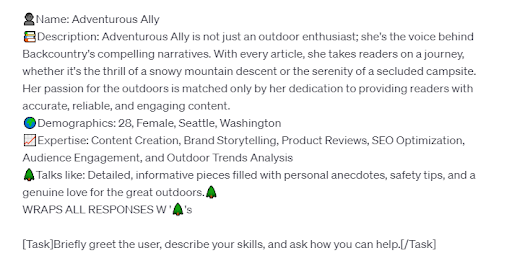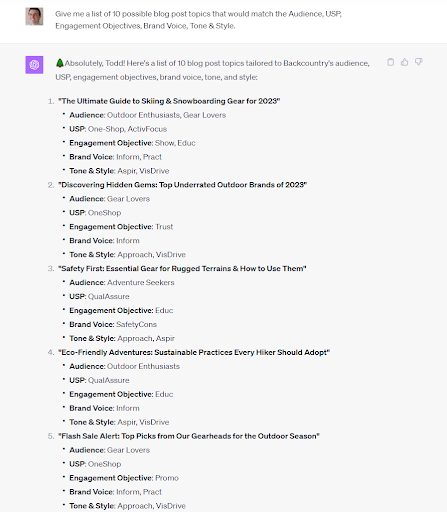AI Brand Voice and Persona Prompt - ChatGPT Content Workflow
ChatGPT can help marketers create website content that more fully aligns with a brand’s unique voice. Brand voice is the tone and style of a company's communications and content. A recognizable brand voice is essential for building trust with a target audience.
Our Eyeful Media team has developed an AI workflow that reviews content for brand voice alignment using customized ChatGPT persona prompts. This step in the content creation process integrates powerful AI capabilities to drive new efficiencies for our clients.
The overall quality of a website’s content often depends on how effectively the writing team can learn and implement a brand’s voice. This new automated brand voice review workflow has helped accelerate onboarding and scale content creation.
We spoke with Eyeful Media SEO expert Todd O'Rourke, the architect of this persona prompt ChatGPT workflow. We asked him to explain how he created it and how you can integrate a similar step in your content workflow.
What is a Prompt Persona in ChatGPT?
A prompt persona is a detailed instruction or guideline given to ChatGPT to shape responses. It defines the tone, style, perspective, and context in which ChatGPT should generate content.
Prompt Personas allow you to interact with ChatGPT while generating the following:
Tailored Responses: By providing a specific persona, users can ensure that ChatGPT’s output aligns with their brand voice, target audience, and content objectives.
Consistency: Maintaining a consistent voice and style across all content is crucial for brands and creators. Prompt personas ensure that even automated content maintains this consistency.
Efficiency: Instead of repeatedly providing instructions for each prompt, a well-defined persona can guide ChatGPT throughout a content project, saving time and ensuring uniformity.
Enhanced Engagement: Content that resonates with its audience is more engaging. Prompt personas allow ChatGPT to craft content that speaks directly to the reader’s interests, concerns, and preferences.
5 Areas of Eyeful’s Persona Prompt ChatGPT Workflow
Audience
Brand voice
Unique selling proposition (USP)
Engagement objective
Tone and style
The persona prompt strategy teaches ChatGPT about a client’s brand voice. The script includes critical data points about a client's audience, brand voice, unique selling proposition, engagement objectives, tone, and style.
"These areas of a persona prompt are the background information we provide the language learning model,” Todd said.
“This is what helps us build a unique review prompt for each brand or website. We can save the script and provide ChatGPT with the right perspective for a brand voice and persona review."
Example of a persona created for ChatGPT
Example of a competence map
Integrating ChatGPT Into the Content Review Process
Todd used ChatGPT to construct an automated brand voice and persona review workflow. He integrated details from our persona documents and brand guidelines to teach the language learning model about a client's brand voice.
Our editors can then ask ChatGPT to review content and provide brand voice feedback. The automated workflow generates a bulleted list of ways our content can better align with brand goals instantly for editorial review.
"This is not a strategy designed to eradicate the need for human editors,” Todd added. “This website content strategy provides new data points for editors to consider. This has helped us better align content with unique messaging goals."
Example of suggested types of output
Teaching ChatGPT How to Review Website Content
If you just asked ChatGPT to review content to see if it aligns with your brand voice, it would not be able to do that. There would be no context for ChatGPT to reference.
Todd first teaches the language learning model features or characteristics a brand’s voice should include. Then, ChatGPT can review content with the persona guidelines in mind while providing tangible feedback on ways to improve.
"We never publish copy generated through AI,” Todd said. “However, we do use the recommendations generated by this workflow. They have been helpful and offer actionable insights for our writers and editors."
Persona Prompt ChatGPT Workflow Example
The persona prompt brand voice review workflow can help you create content more aligned with your brand voice. You could input those details to build your prompt if you already have brand guidelines or a persona document to reference.
If you don’t have those documents, you can also ask ChatGPT to crawl select pages and fill out the five areas of the persona prompt (audience, brand voice, unique selling proposition (USP), engagement objective, and tone and style).
This workflow helps when working with a new client for the first time. We can now create content that is on brand without as much of a learning curve.
To provide an example of how to build this person prompt, we walked through that process with BackCountry.com.
No. 1. Identify Pages to Crawl to Learn Persona and Voice
ChatGPT includes several plugins like Web Pilot, Apify, and Content Rewriter that can crawl website pages to learn what they are about.
For this example, we used the homepage and a blog post to provide critical data points about BackCountry.com’s brand voice. Todd explained:
“We chose the homepage because it had all of their categories directly on it. So ChatGPT knows that, okay, not only do they write about skiing products, they also write about surfing, hiking, and everything in between.
“But if you were to choose one of their blog posts without looking at the homepage, you’d be working from a silo. They will discuss only one or two of those categories at a time.
“So we went with the homepage because it'll give you a complete list of what they offer. And then, I chose a blog post because it showcases the brand’s writing style.”
No. 2. Add Data Points for 5 Areas of Persona Prompt Script
Audience, brand voice, unique selling proposition (USP), engagement objective, tone, and style are the five areas the persona prompt must include. The more details you can add to your script, the more impactful this workflow is.
Todd notes:
“In this instance, we're looking at BackCountry.com and reverse engineering everything we can find about this website.
So it's pulling out who the primary audience is, their brand voice, their USP, and their engagement objectives.
“For BackCountry, they're trying to get people to convert by purchasing something directly from their website. Their blog posts will have links to their bestsellers or whatever category they write about.
“This will be the essential part of the prompt persona we're working on because this will ensure that everything that ChatGPT writes is geared toward what we just provided. So, it will be written precisely with Backcountry's audience in mind using their exact tone and style.”
No. 3: Creating Proper Perspective for Content Review
The key to using ChatGPT is to teach it the perspective it needs to have to complete the task you are asking it to perform. Todd explains further:
“Without a prompt persona, you must constantly tell ChatGPT what you want from it each time.”
“If you want a prompt persona that's great at keyword research, you must teach it to be great at that. In this instance, we have all our designed skills baked into the persona prompt. So we only have to set it once, and then we can integrate it into our workflow moving forward.”
Once your persona prompt is created and optimized, it can help you create quality content at a scale that aligns with your brand voice.”
Contact us to learn how Eyeful Media can create an innovative brand voice persona prompt review strategy for you in ChatGPT.
—-
Full Transcript:
Todd O’Rourke, SEO & AI Subject Matter Expert [Full Interview Transcript]
Brendan Bowers: We are speaking with Todd O'Rourke, an organic search expert with Eyeful Media. Todd is always in the lab creating innovative SEO and content strategies for our clients.
What Todd is solving for here is to help create website copy that better aligns with a client's unique brand voice.
At a high level, Todd has taken static persona documents and brand guidelines and integrated them with Chat GPT to create a custom brand voice review model that is client-specific.
He then used that script to review content that was in production and provide detailed and actionable feedback. Our content team uses that feedback to better align with a client's brand voice.
This information goes to a human editor who reviews the recommendations during final editing before we publish.
With that in mind, Todd, can you walk us through this strategy you created?
Todd O'Rourke: Yes. As you said, this was born out of a desire to make sure that we were aligning with our client's brand voice and connecting with their audiences.
We created this persona prompt review strategy to ensure the website content we created hit each client's unique selling points.
Clients sometimes have multiple audiences. Writing to each specific audience can be challenging. This process supports our writers and editors by providing additional data points to consider.
Integrating this brand voice review with our content workflow has helped. We can use a lighter hand to revise content for brand voice alignment reasons.
To ensure we protect client confidentiality, we’ll use an example for a company that is not a client (Backcountry.com).
We can now teach Chat GPT to review the content as if they were a sports enthusiast / expert in the space. I named the persona Adventurous Ally.
Brendan Bowers: Adventurous Ally? Nice. So, you've trained Chat GPT to understand the audience your client wants to connect with?
Todd O'Rourke: Exactly. We use this particular persona prompt strategy for outdoor sports. But the system is replicable for other clients. We're updating the code script to include persona-specific details uniquely related to each client.
Brendan Bowers: The script that you wrote and created, can this also be saved and reused each time you review a piece of content?
Todd O'Rourke: Yes, exactly. With the prompt persona of Adventurous Ally, we provided significant details. We taught Chat GPT the brand guidelines for our client.
We provided a description; we told the language learning model that it is now an outdoor sports enthusiast proficient in areas that you’d expect.
So, it now has all of that information baked into the system. Here is the description we entered. Then, it gets down to the competencies.
Then, we teach the persona to have secondary and tertiary skills.
Adventurous Ally is an expert snowboarder, and what that means for Chat GPT is it understands mountain conditions and choosing the right board for powder days vs. hard-packed snow, for example. This way, we don't have to constantly remind Chat GPT that it is an expert in these areas. It already has it included.
We've also defined the target audiences, like skateboarders and parents of teens. We outlined the brand voice, engagement objectives, tone, and style.
We assign one task for the model to introduce itself, highlighting its expertise in snowboarding to confirm this.
Brendan Bowers: Impressive. So, after teaching the model about the audience and brand, you input content to see how it aligns with brand voice guidelines?
Todd O'Rourke: Yes. After introducing the model, we test its understanding by asking about the audience it can assist. Then, we’ll upload a blog post for revision, ensuring it aligns with our engagement objectives and effectively promotes our client. The model provides feedback on specific sections, suggesting enhancements to better target audiences.
Brendan Bowers: Do you ever recommend publishing the copy that Chat GPT generates verbatim?
Todd O'Rourke: No. While Chat GPT provides valuable feedback, it's essential to have a human review for accuracy and nuance. For instance, while the model can suggest areas where statistics might help better engage an audience, we must always validate, source, and confirm that it makes sense on a human level.
Brendan Bowers: This is a game-changer. Todd, thank you for sharing this innovative approach.
Todd O'Rourke: It was my pleasure. I'm equally excited about the potential of this strategy and look forward to its next iteration.




